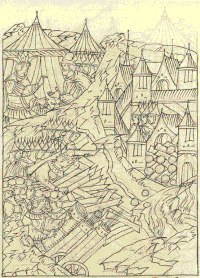Siege of Kazan
| Siege of Kazan | |||||||
|---|---|---|---|---|---|---|---|
| Part of Russo-Kazan Wars | |||||||
 The illustration in chronicle |
|||||||
|
|||||||
| Belligerents | |||||||
|
Tsardom of Russia Qasim Khanate Taw yağı 1 |
Khanate of Kazan Cheremis and Ar warriors Nogay cavalry |
||||||
| Commanders and leaders | |||||||
|
Ivan IV "the Terrible" Alexander Gorbatyi-Shuisky Andrey Kurbsky Shahghali |
Yadegar Moxammat (POW) Yapancha bak † Zaynash morza (POW) Qolsharif † |
||||||
| Strength | |||||||
| 150,000 men, 150 cannons unknown battleship some siege towers |
33,000 men2- 50,000, including civilians3 unknown cannons |
||||||
| Casualties and losses | |||||||
| 15,3553-? unknown wounded |
Around 65000 dead or missing (including civilians)3 more than 190,000 captured 3 many thousands displaced |
||||||
|
1Involvement disputed 2Tatar Encyclopaedia 3Kazan Chronicle; it is likely that this source underestimates Russian and overstates Tatar casualties |
|||||||
The Siege of Kazan in 1552 was the final battle of Russo-Kazan Wars. It led to the fall of Khanate of Kazan. However, it was not the last battle on the khanate's territory. After the fall of Kazan, rebel governments formed in Çalım and Mişätamaq, and a new khan was invited from the Nogais. This continuation guerrilla war was ended only in 1556.
The Russian forces included streltsy as well as Moscow and Qasim irregular feudal cavalry, but the Muscovite artillery and sappers, both Russian and foreigners, played a vital role. At first they faced the Tatar garrison of Kazan, 10,000 Nogay horsemen led by the khan of Kazan, Yadegar Mokhammad, who originated from the Nogai Horde. Cheremiss units and Kazan irregular feudal cavalry had bases in forests north and east of Kazan respectively. Their base was the stronghold of Archa. Before the battle Russians had a fortress on the Volga, Ivangorod, later known as Sviyazhsk, some miles above Kazan. The Russian military engineer Ivan Vyrodkov had built this wooden fortress in 1551, when after the conclusion of peace, the right bank of the Khanate (Taw yağı) had passed to Russia. It would serve as a strong point for the capture of Kazan by the Muscovite army.
...
Wikipedia
